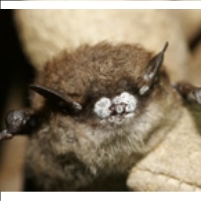If You Think Times Are Tough for Pigs, Try Being a Bat
Saturday, May 09, 2009
 Bat with White Nose Syndrome (photo courtesy Ryan von Linden-New York Department of Environmental Conservation)
Bat with White Nose Syndrome (photo courtesy Ryan von Linden-New York Department of Environmental Conservation)
The U.S. Forest Service is closing thousands of caves and former mines in national forests in thirty-three states in an effort to suspend the spread of white-nose syndrome, a fatal fungus that has already killed an estimated 500,000 bats. Bats, although much maligned, help humans by eating mosquitoes and other bugs.
Distinguished by white powder on the face and wings of hibernating bats, white-nose fungus was first sighted in New York, and within two years, has spread to caves in Connecticut, Massachusetts, Vermont, West Virginia and Virginia. The fungus causes bats to awaken from hibernation prematurely because they have used up their reserves of body fat. Leaving caves in search of insects that have not yet emerged, the infected bats die during their search for food. In some colonies, there has been 90 to 100 percent mortality, and a cure has yet to be found.
While there is no evidence the fungus is harmful to people, it is still unknown whether bats are spreading the fungus from cave to cave or if traveling humans are transmitting it from their shoes and equipment.
To be safe, the Forest Service issued a mandatory order last week for the closing of caves in 20 states from Minnesota to Maine, and a second order covering the Forest Service’s 13-state Southern region will be issued later this month. According to the order, trespassers face up to six months in jail and fines of up to $10,000. The closures are expected to last until April 2010.
Biologists are concerned that the fungus could bring endangered Indiana, Virginia and Ozark big-eared bats to extinction. Bats play a significant role in keeping the population of insects, such as mosquitoes, under control. The loss of 500,000 bats to White Nose Syndrome means 2.4 million pounds of bugs are not eaten in a year.
-Melanie Young
Caves Closed in Effort to Stop Spread of Deadly Fungus (by Kelly Burgess, Los Angeles Times)
White Nose Syndrome Page (National Speleological Society)
- Top Stories
- Unusual News
- Where is the Money Going?
- Controversies
- U.S. and the World
- Appointments and Resignations
- Latest News
- Trump to Stop Deportations If…
- Trump Denounces World Series
- What If China Invaded the United States?
- Donald Trump Has a Mental Health Problem and It Has a Name
- Trump Goes on Renaming Frenzy






Comments